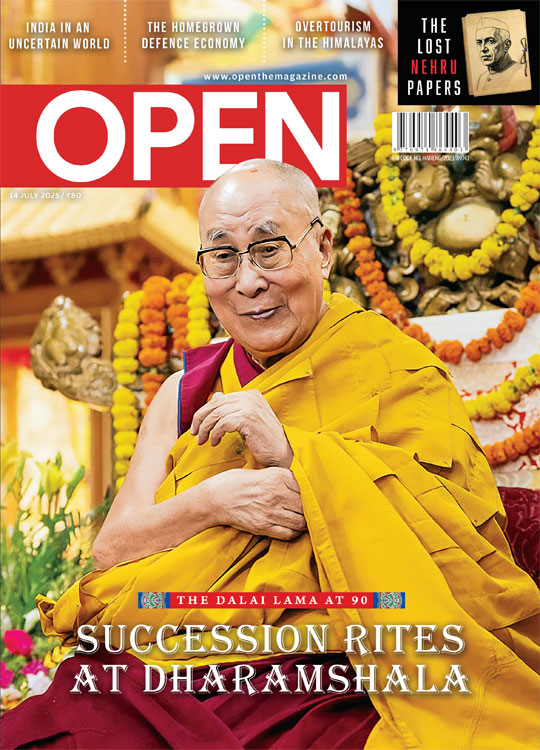Rahul Gandhi and the Last Rites of a Notional Party
A sense of ending
 Sumantra Bose
Sumantra Bose
 Sumantra Bose
|
16 Mar, 2017
Sumantra Bose
|
16 Mar, 2017
/wp-content/uploads/2017/03/Senseending1.jpg)
THERE IS AN expression in the colourful vocabulary of Bengali slang: laejur. It is derived from ‘laej’, the word for ‘tail’. The laejur is a creature that, lacking a face, body and voice that can enable it to exist independently, attaches itself as a tail to someone else in order to survive. In other words, a parasite.
Indian politics has a laejur in the form of the tragic remnant of the party once helmed by Mohandas Karamchand Gandhi and led by Jawaharlal Nehru and Subhas Chandra Bose, among numerous other luminaries. On no less than three occasions during just the past one year, this ragged, lost outfit has affixed itself as the proverbial laejur to other parties in assembly elections in large, populous states in three different parts of the country. Each time, the outcome has been the same and the lesson unmistakable.
In 2011, the Communist Party of India (Marxist) was booted out of power in West Bengal after 34 years in government. The Bengal CPM, self-reduced to little more than an election machine over three decades, proved unable to use the opportunity provided by defeat to rejuvenate and rebuild itself as a political force. Instead, deprived of the power that had been its sole source of oxygen for many years, it behaved like the proverbial fish taken out of water. It floundered about aimlessly as Mamata Banerjee seized the initiative—on a far smaller and provincial scale, not unlike how Narendra Modi has built his brand nationally since his 2014 triumph—to consolidate her position as the new voice of Bengali regionalism on the Indian political scene and an advocate of the state’s poor and their needs. The CPM’s popular base in Bengal shrank progressively and alarmingly. It was routed by the Trinamool Congress in panchayat polls in 2013 and got through in just two of the state’s 42 Lok Sabha constituencies—both by very thin margins—in 2014. As the 2016 Assembly elections approached, the growing crisis of self-confidence of the Bengal CPM leadership led them to calculate that they lacked the capacity to confront the Mamata juggernaut on their own. Grasping for succour from any quarter, the party’s central leadership acquiesced in a pre-poll alliance with the Congress. The latter, reduced to 8 per cent of the Lok Sabha and nearly irrelevant in the politics of West Bengal, was only too glad to reciprocate.
The Bengal opposition alliance was grandly billed as a ‘janaganer jote’—an alliance of the people—by its proponents in both parties. Its statistical basis was that in the 2014 General Election, the TMC’s vote share was 39 per cent, equal to the vote shares combined of the Left Front and the Congress, at 30 and 9 per cent respectively. The plurality vote share had netted the TMC 34, or 81 per cent, of the state’s 42 Lok Sabha seats (a nearly identical vote share has given the BJP an almost identical proportion of the Uttar Pradesh Assembly elected in 2017). So, the reasoning went, if the LF and the Congress joined forces and jointly attacked Mamata— focusing in particular on the ruling Trinamool’s weakest spot, its reputation of financial avarice at all levels of the party—the eviction of Mamata from power was distinctly possible.
In the patches of the country where Congress survives as a political force, it does so in spite of the high command, not because of it
This was a delusion. Electoral politics is fluid and dynamic, and as the BJP has shown in Uttar Pradesh, a winning strategy has to go beyond crude, static calculations of prior voting percentages. The CPM-Congress alliance had no alternative vision or positive agenda to offer for Bengal. Its sole point was the rudderless, drifting CPM’s desperation to reclaim the lost fortress that had for over three decades given it a limited weight in national politics from Mamata’s stranglehold, and the Congress ‘high command’, equally bankrupt and desperate, was willing to go along. The tie-up in fact made no political sense from the perspective of the CPM’s ambition because in approximately three-fourths of West Bengal’s Assembly constituencies, about 220 of 294, the Congress vote was negligible (in the lower single digits in percentage terms). The addition of this derisory percentage to CPM’s own steadily dwindled vote would thus make no difference to the outcome in the large majority of Assembly constituencies. But the delusion steamed on regardless, drunk on its own propaganda.
The defining moment of the Bengal election of 2016 came as the campaign neared its climax. This happened at a joint CPM- Congress rally at Kolkata’s Park Circus maidan, in the area of central Kolkata around which the bulk of the city’s 21 per cent Muslim population live. The erstwhile Chief Minister (November 2000 till May 2011) Buddhadeb Bhattacharjee, the quintessential bespectacled bhadralok communist, clad as always in the trademark white dhoti and Panjabi (‘kurta’ in north Indian translation) typical of the overwhelmingly high-caste Bengal CPM hierarchy, giddily rushed forward on the dais, eyes glazed over with adoration, to envelop a newfound comrade visiting from New Delhi in a warm embrace. It made for a touching photographic image, just as the two forty-somethings exerting themselves together on the Uttar Pradesh campaign trail provided a few Kodak—or in this era Instagram—moments.
The embrace of the septuagenarian communist and the middle- aged dynastic scion visiting from New Delhi, and the opportunist gang-up it symbolised, rebounded to Mamata Banerjee’s advantage. When the results came in a fortnight later, the TMC won close to a three-fourths majority, 72 per cent, in the West Bengal Assembly, 211 of the 294 constituencies (with a decisive edge in the vote share, 45 per cent to the alliance’s 38 per cent). It could easily have been more; the TMC lost at least a dozen seats due to factional in-fighting. I admittedly cannot corroborate this, as it’s what known as a ‘counter-factual’ scenario in social and political science, but it is my assessment—and I happen to understand the nuts and bolts of Bengal politics a bit—that had the CPM-led LF contested the election on its own as a principled opposition to the Trinamool regime, it would have won around three times the seats it did. The LF won just 32 seats (halved since 2011) and the CPM won 24 of those, a performance as abject as that of the Congress in the post- Emergency election of June 1977 which brought the LF to power, when the Congress won just 20 seats in West Bengal’s 294-seat Assembly. The Trinamool would still have won a majority, propelled by Mamata’s personal popularity, but the CPM would not have suffered the decimation it did.
It is now clear that the Congress albatross damaged Akhilesh’s chances further and squandered the goodwill his government had earned. Rahul Gandhi should have been left in peace to continue his symbolic khatia gatherings
Due to the local specificities of Bengal politics, where the Congress vote was concentrated in a few north and central Bengal districts, the Congress won 44 seats (almost the same as it obtained as a Trinamool laejur in 2011), of which a third came from southern Bengal—where the Congress is practically non-existent— thanks to transferred CPM votes (the alliance shared seats in a 2:1 ratio, with the LF contesting two-thirds of the seats state-wide and the Congress the other one-third). This is superficially different from Uttar Pradesh, where the Samajwadi Party has lost 80 per cent of its sitting strength (47 from 224) and the Congress 75 per cent (seven, down from 28 in 2012), but otherwise the parallels are clear. The Congress’ 40-odd MLA strength in the current West Bengal Assembly—several have defected to the TMC since the election, and more will surely follow—is not an accurate barometer of the Congress’s near-extinct status in the state.
At the same time as this farce unfolded last year in Bengal, the leadership of the Dravida Munnetra Kazhagam made a crucial error of judgment. Nervous at the obvious personal popularity of the late J Jayalalithaa, riding on numerous populist ‘Amma’ schemes, and rattled by the sibling rift in its owning family, the party conceded nearly a fifth of the seats in the Tamil Nadu Assembly to the Congress—whose presence in the state can be charitably described as marginal—in a seat-sharing deal concluded after Ghulam Nabi Azad visited M Karunanidhi in Chennai as an emissary of his high command. When the results came out, it became clear that the DMK had fatally over-estimated Jayalalithaa, and under-estimated itself. The DMK won over half the seats it contested—89 of 176—whereas the less-than-puny Congress, the beneficiary of its misguided generosity, could win fewer than one of every five seats it contested (eight of 41). Even in severe defeat, the SP in Uttar Pradesh has won almost one in every six seats it contested, while the Congress success rate is 7 per cent. Accommodating the parasite may have cost the DMK Tamil Nadu by a whisker.
There is, of course, the seemingly anomalous case of Bihar in 2015. But it is possible, maybe even probable, that the Lalu-Nitish combination would have pulled off a victory without the Congress tagging along as an insignificant appendage, albeit perhaps with a smaller majority. The two regional warlords had mutually complementary strengths—as an SP-BSP alliance would in UP—and were helped by a series of costly mistakes the BJP made in its electoral strategy. Had the SP contested in UP on its own, it is still very unlikely that it would have been returned to power, given the appeal of the Modi factor, the finely tuned campaign masterminded by Amit Shah, and the gross public spectacle of the SP’s inter-generational and family feud. But it is now clear that the Congress albatross damaged Akhilesh’s chances further and squandered the goodwill his government had earned. Rahul Gandhi should have been left in peace to continue his shambolic khatia gatherings.
The more the Congress fades and the tail shrivels to a stub, the more its owners’ comical band of retainers bang on that theirs is a ‘national party’. The pretension is in exactly inverse proportion to the unfolding reality. After the 2014 debacle, any national party worth its salt would have striven to protect its base from further erosion, especially in states where it still had a sizeable presence. In the just concluded rural polls in Odisha, the Congress has been nearly wiped out through decay, neglect and drift, while the BJP has emerged as a strong challenger to the ruling BJD, and as the leading party in the state’s non- coastal interior districts. In Maharashtra’s party politics, the BJP has catapulted itself from fourth to first place in just a few years, with the shrunken Congress now reduced to competing with its aimless offshoot, the NCP, for the last position among the big four. At this rate of attrition, it looks likely that the one larger state where the Congress still has a government—Karnataka (28 Lok Sabha MPs)— will fall to a resurgent, reunited BJP in the Assembly elections just a year away.
In the patches of the country where the Congress survives as a political force, it does so in spite of the high command, not because of it. Old warhorses like Captain Amarinder Singh in Punjab and Ibobi Singh in Manipur knew very well that the dynastic heir is truly blessed—with what is known as the reverse Midas touch—and made sure to keep him at arm’s length to the greatest extent possible. The Captain, it may be recalled, was on the verge of quitting the party in disgust just a year or two ago. His forbearance paid off. The fed-up Punjab electorate put their trust in the seasoned Patiala royal, rather than the posturing clique around Delhi Chief Minister Arvind Kejriwal.
The increasingly uphill task of stitching together a viable opposition to the Modi regime remains essential, and will become ever more urgent over the next two to seven years. Those who will have to engage in this complex endeavour should heed this warning: beware the tail that barely wags.

/wp-content/uploads/2025/07/Cover_Dalai-Lama.jpg)













More Columns
Mothers and Monsters Kaveree Bamzai
Nimrat Returns to Spyland Kaveree Bamzai
Return to the Assassination Kaveree Bamzai